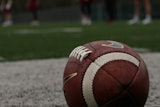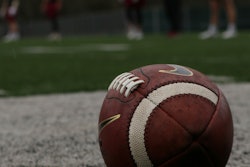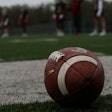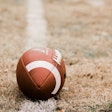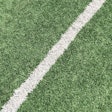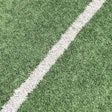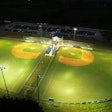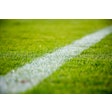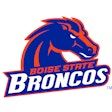Global warming debates aside, this summer was hot. And dry. By mid-July, 64 percent of the country was suffering from drought conditions, the worst since the 1950s.
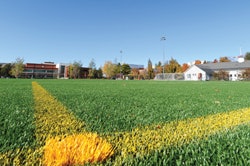
Global warming debates aside, this summer was hot. And dry. By mid-July, 64 percent of the country was suffering from drought conditions, the worst since the 1950s. Anyone spending any time outside was affected. In Madison, Wis., the parks and recreation department began asking people to stay off the city's athletic and recreation fields, fearing long-term damage.
"The natural-grass fields are so dry, they're playing the way they'd play in middle to late August," Jim Dobmeier, president of the Cheektowaga, N.Y.-based synthetic turf manufacturer A-Turf, said at the time of his own local ball fields. The scorching heat and lack of rain were taking their toll on natural-grass fields, and watering restrictions in many areas left communities with few options.
For some, the drought conditions highlighted advantages synthetic turf fields hold over natural grass. "You don't have to water a synthetic field," says Josh Kaplan, assistant athletic director of facilities, operations and events at the University of Maryland, which replaced the natural grass field at Byrd Stadium with a synthetic system that opened in August. "There is no growth. It's one of those things that, when there is a drought, you don't have to concern yourself with."
Whether already planning a field upgrade or seeking to undo the damage done by nature, Dobmeier expects many field owners to give synthetic turf an extra look. "It's a turning point for some school boards and decision-makers."
While synthetic turf has the advantage of being impervious to drought conditions, the fact has been well established that it is more susceptible to high temperatures than its counterpart. "Synthetic fields are basically plastic fiber that has a petroleum base," explains Brad Fresenburg of the University of Missouri Turf Research Center, comparing the materials to the dashboard of a car sitting in the sun. "Synthetic turf is no different. These types of products tend to absorb heat and get quite hot. Temperatures that we see quite often can be 30 to 40 degrees higher than the natural grass surface, but there are some extremes."
During the record-setting heat of June, Missouri experienced several weeks of triple-digit temperatures. "We were looking at our synthetic surfaces and consistently reading in the 170s. Our turf grass was getting temperatures right around 105," Fresenburg says.
Playing in hot weather is enough of a concern for athletes without adding extra heat. "That reflective heat will wear on you. Just to stand on it will take a toll on you, not to mention any type of physical activity," says Fresenburg. As such, synthetic turf owners and manufacturers alike have sought various options to bring down the field temperature. Watering the fields is one option, but not the most practical. Even when water restrictions aren't an issue, the results are fleeting. "You can cool down the surface with an application of irrigation - you can get a 30- to 40-degree drop - but once that water evaporates, the temperatures are right back up there," Fresenburg says.
Moreover, focusing on lowering the field temperature doesn't address the real concern - player safety. "People become dehydrated and exhausted in heat. It's an issue of athletes trying to perform their best," says Dobmeier. First and foremost, general safety precautions should be taken for any athletes playing or practicing outdoors, no matter what type of surface they're on. "We constantly recommend to players, coaches and parents that anybody who's going to spend an extended amount of time on the field get hydrated and remain hydrated," Fresenburg adds.
In addition, the Synthetic Turf Council and other industry professionals recommend watering the athletes rather than the field. Misting stations can help lower athletes' body temperature, keeping them from overheating, and does so using only a fraction of the amount of water required to cool an entire field. Says Dobmeier, "Using a mist station for six hours uses a maximum 30 gallons of water. Athletes can go through it during practice and it will have more impact than watering the whole turf down."
Fresenburg also recommends playing or practicing earlier in the day, if possible. The Turf Research Center has found that the temperature of synthetic turf most closely correlates to air temperature early in the morning, gaining heat throughout the day and remaining hotter even into the evening hours after air temperatures have cooled. "The heat tends to hang in 20 to 25 degrees higher than the air temperature going into the evening hours," he explains. "But overnight it dissipates and the temperature drops back down to match the air temperature."
The reading on the thermometer is not the only factor to impact field conditions, Fresenburg adds. "On a day when you have partly cloudy skies, a cloud passing in front of the sun could drop the temperature 30 to 40 degrees," he explains. "We also know that on a clear day when we're getting into that 160- to 170-degree range on the surface and add a 5- to 10-mph breeze, that will take the temperature down approximately 20 degrees. A breeze on a bright sunny day really does help."

Turf manufacturers are seeking out other methods to cool down fields. "There is some development going on, technology in the works to create a system that cools from underneath the surface," says Dobmeier. Similar to an air conditioner, the technology would generate cool air through a system of ducts beneath the field and blow it upward, creating a pocket of cooler air surrounding athletes on the field. "It probably makes a whole bunch of sense particularly for those in the Southern states or higher-profile programs - not just as a means to safety, but attracting athletes," Dobmeier continues. "But to be realistic, given today's world of dollars and budgets, it's never going to be the common solution to everyday field cooling."
Montreal-based turf manufacturer FieldTurf has been working on more practical and realistic alternatives. Its first synthetic field featuring CoolPlay technology was unveiled in August at Maryland's Byrd Stadium, and the company plans to fully launch the technology as part of its 2013 line. "We've been looking at this issue for a long time," says vice president of global marketing Darren Gill. "It's been top-of-mind for our customers."
When making the decision to replace its natural grass field, Maryland's athletic department wanted a solution that would allow maximum field usage, says deputy director of athletics/chief operating officer Kelly Mehrtens, "whether giving our student groups an opportunity to utilize it when our athletic programs weren't using it or hosting a large soccer match. It gives us more flexibility to do more things, and could become a community resource, as well."
At the same time, though, the university wanted to make the transition as smooth as possible for its athletes, which meant keeping the field temperatures as close to what they were used to as possible. Using new infill material and silica sand, the field's CoolPlay technology purports to keep a synthetic field 15 degrees cooler. "We're excited to see it in place, and we believe we're partway to finding a major solution to field cooling," says Gill, adding that there's still more work to do. "Although we're getting cooler, we're not quite natural-grass cool, and that's our objective. We also have some fiber research being done, but that is going to take a little longer."
Cooling a field by 15 to 20 degrees may take some of the edge off, but Fresenburg warns that heat will still be an issue. "When you're in a situation when, maybe during spring or fall, your field temperatures are only getting to 130 degrees or so and you can bring it down 15 degrees, yes, you can probably get a bit of an advantage. But most of the time during the summer months, if you're at 165 and bring it down to 150, that's still hot."
Even so, when athlete safety is at stake, whatever measures can be taken to mitigate temperature differences are welcomed. And small improvements can provide the impetus for larger ideas. "I think we're taking a major step in changing the way people think about one of the key issues in the business," says Gill.
The difference in cooling, whether it's enough to provide a noticeably more comfortable playing temperature for athletes or not, will undoubtedly give the university a different kind of competitive advantage. "There is a significant degree of cooling compared to some of the turf options installed at other colleges and universities," says Mehrtens. "One of the things we pride ourselves on is trying to do a lot with what we have. This definitely gives us an opportunity to showcase Maryland."














